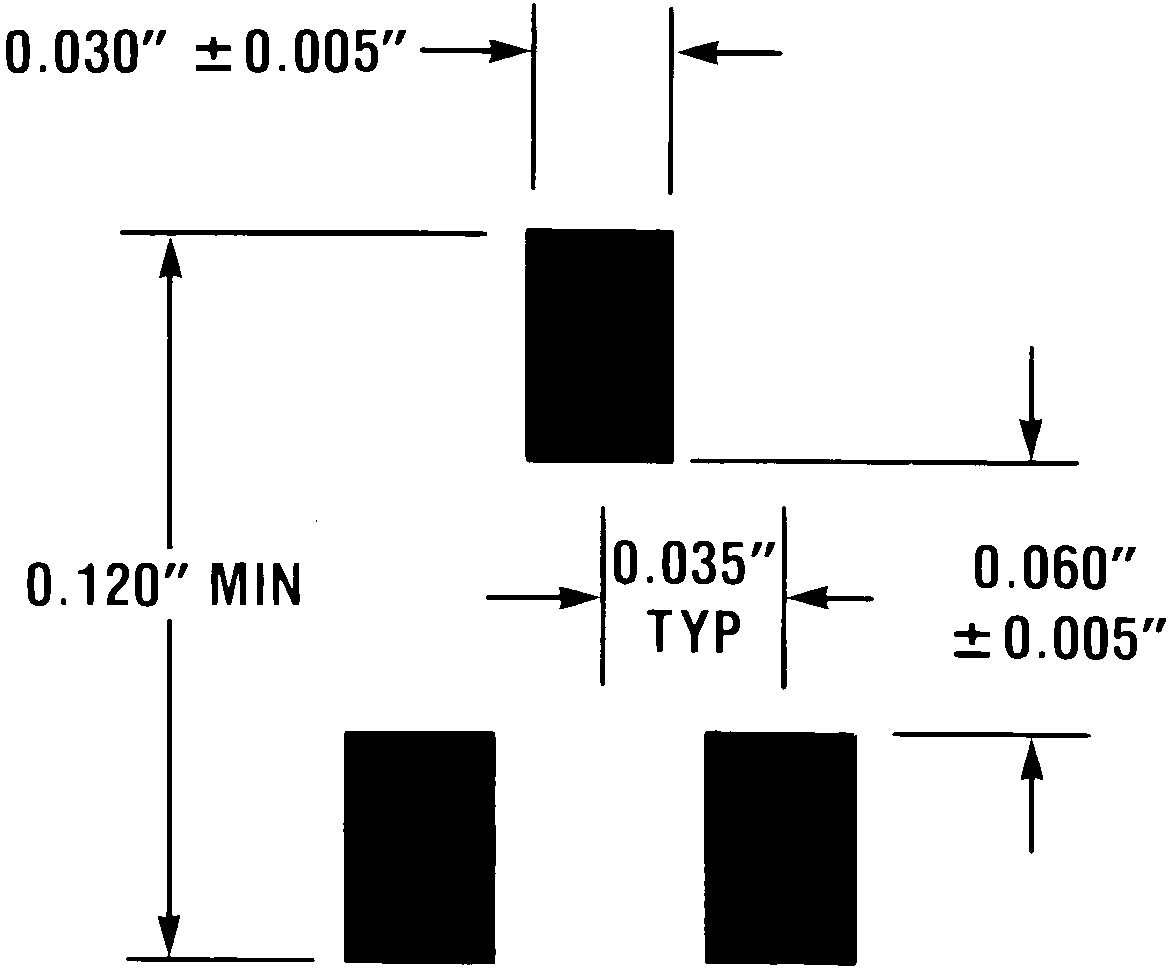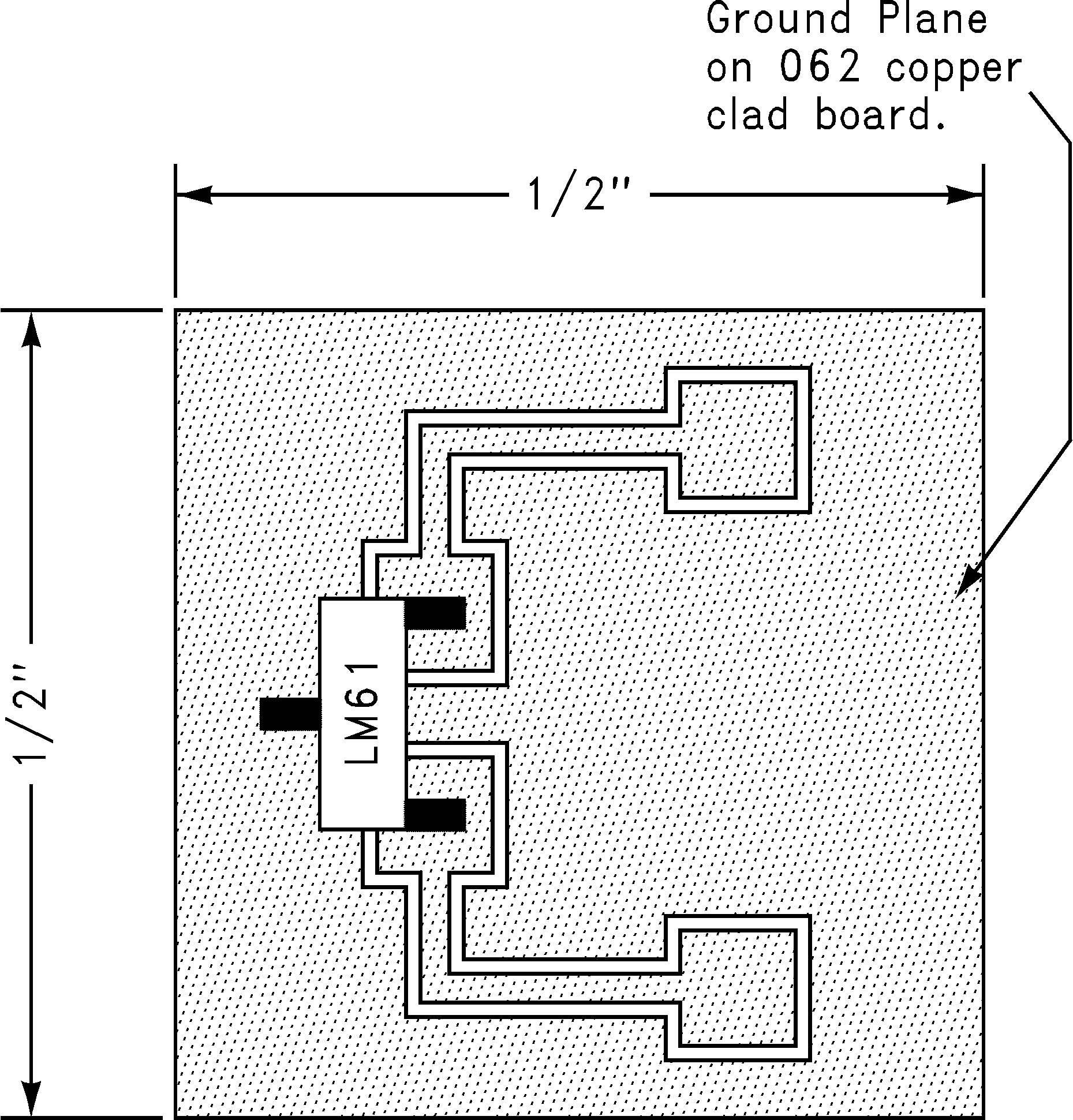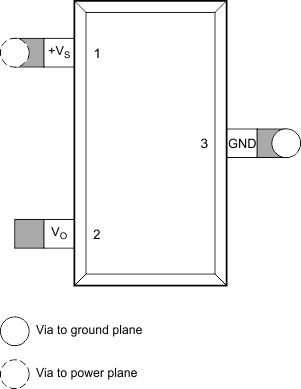JAJS924J June 1999 – November 2016 LM61
PRODUCTION DATA.
- 1 特長
- 2 アプリケーション
- 3 概要
- 4 改訂履歴
- 5 Pin Configuration and Functions
- 6 Specifications
- 7 Detailed Description
- 8 Application and Implementation
- 9 Power Supply Recommendations
- 10Layout
- 11デバイスおよびドキュメントのサポート
- 12メカニカル、パッケージ、および注文情報
パッケージ・オプション
メカニカル・データ(パッケージ|ピン)
サーマルパッド・メカニカル・データ
発注情報
10 Layout
10.1 Layout Guidelines
10.1.1 Mounting
The LM61 can be applied easily in the same way as other integrated-circuit temperature sensors. It can be glued or cemented to a surface. The temperature that the LM61 senses is within about 0.2°C of the surface temperature that LM61's leads are attached to.
This presumes that the ambient air temperature is almost the same as the surface temperature; if the air temperature is much higher or lower than the surface temperature, the actual temperature measured would be at an intermediate temperature between the surface temperature and the air temperatures.
To ensure good thermal conductivity the backside of the LM61 die is directly attached to the GND pin. The lands and traces to the LM61 are part of the printed-circuit board, which is the object whose temperature is being measured.
Alternatively, the LM61 can be mounted inside a sealed-end metal tube, and can then be dipped into a bath or screwed into a threaded hole in a tank. As with any IC, the LM61 and accompanying wiring and circuits must be kept insulated and dry, to avoid leakage and corrosion. This is especially true if the circuit may operate at cold temperatures where condensation can occur. Printed-circuit coatings and varnishes such as Humiseal and epoxy paints or dips are often used to ensure that moisture cannot corrode the device or connections.
10.2 Layout Examples
 Figure 17. Recommended Solder Pads for SOT-23 Package
Figure 17. Recommended Solder Pads for SOT-23 Package

 Figure 19. PCB Layout
Figure 19. PCB Layout
10.3 Thermal Considerations
The junction-to-ambient thermal resistance is the parameter used to calculate the rise of a device junction temperature due to its power dissipation. For the LM61, Equation 2 is used to calculate the rise in the die temperature.
where
- IQ is the quiescent current
- ILis the load current on the output
Table 2 summarizes the rise in die temperature of the LM61 without any loading with a 3.3-V supply, and the thermal resistance for different conditions.
Table 2. Temperature Rise of LM61 Due to Self-Heating and Thermal Resistance (RθJA)
| RθJA (°C/W) | TJ – TA (°C) | |||
|---|---|---|---|---|
| SOT-23 | No heat sink(1) | Still air | 450 | 0.26 |
| Moving air | — | — | ||
| Small heat fin(2) | Still air | 260 | 0.13 | |
| Moving air | 180 | 0.09 | ||
| TO-92 | No heat sink(1) | Still air | 180 | 0.09 |
| Moving air | 90 | 0.05 | ||
| Small heat fin(3) | Still air | 140 | 0.07 | |
| Moving air | 70 | 0.03 | ||
Table 3. Temperature and Typical VO Values
| TEMPERATURE | VO(TYPICAL) |
|---|---|
| 100°C | 1600 mV |
| 85°C | 1450 mV |
| 25°C | 850 mV |
| 0°C | 600 mV |
| –25°C | 350 mV |
| –30°C | 300 mV |